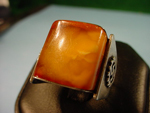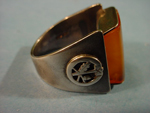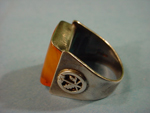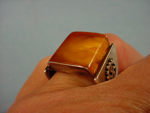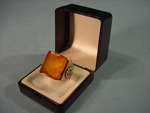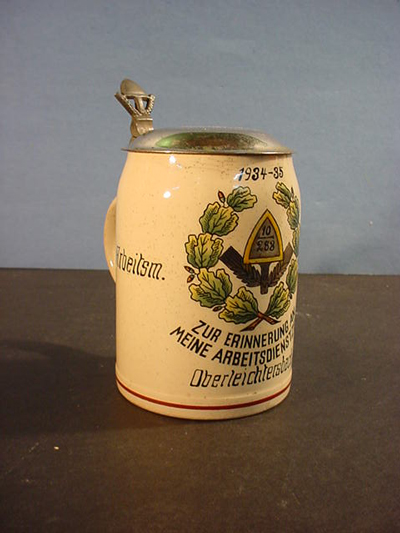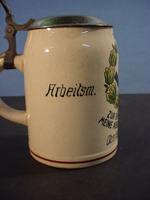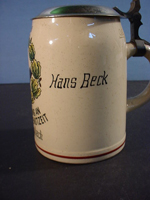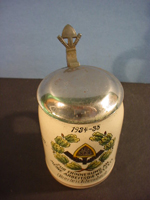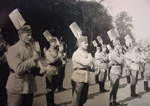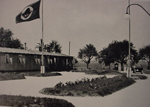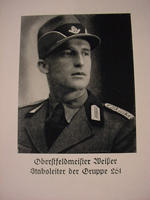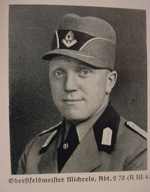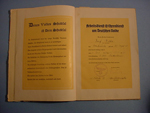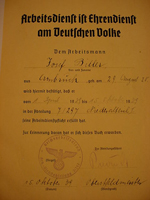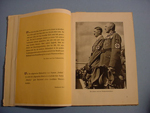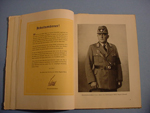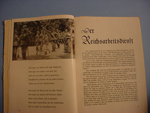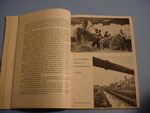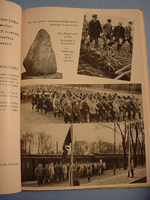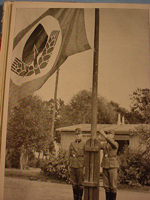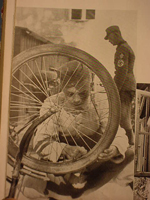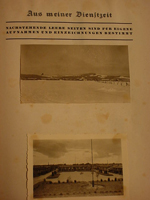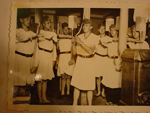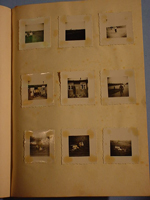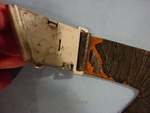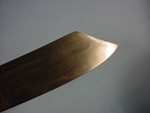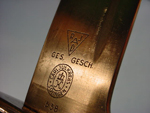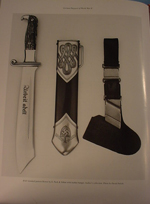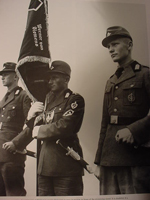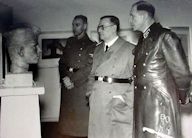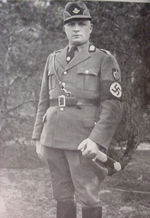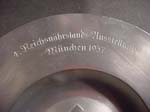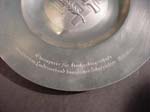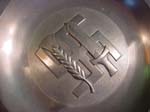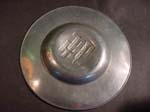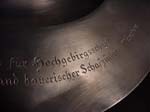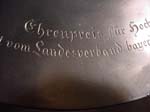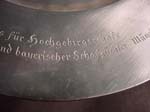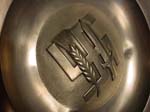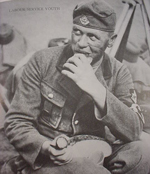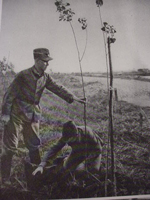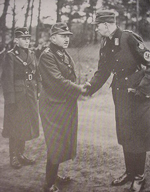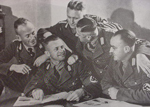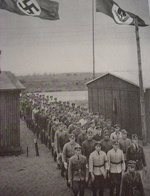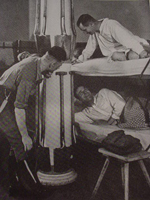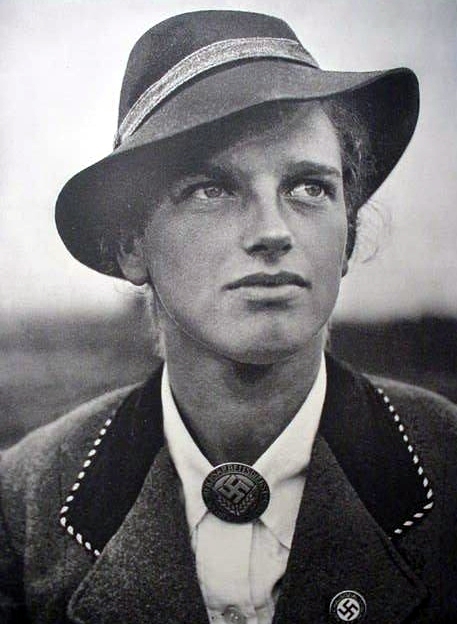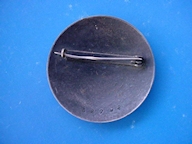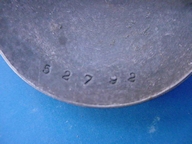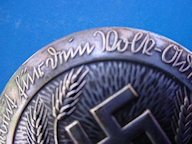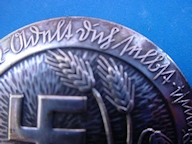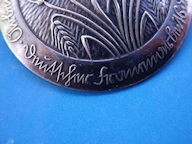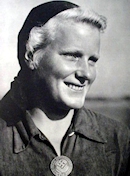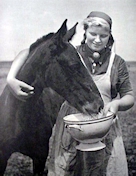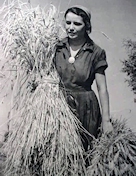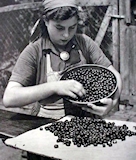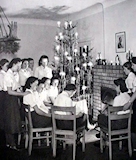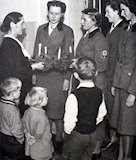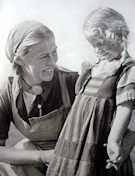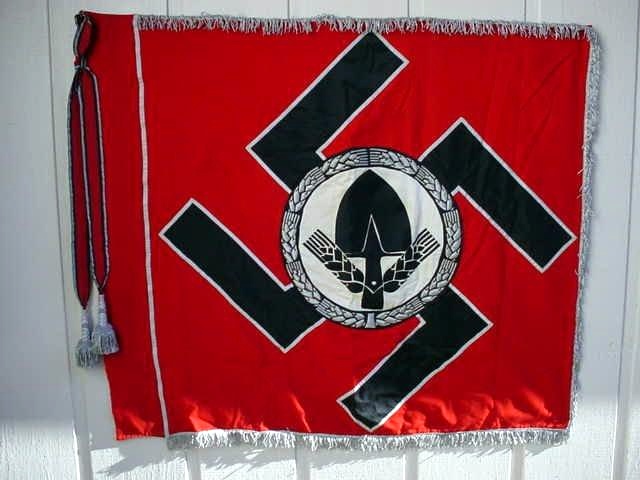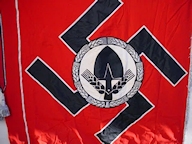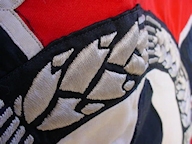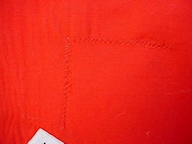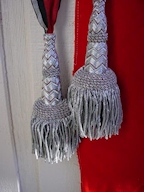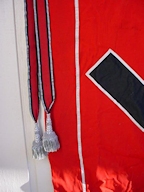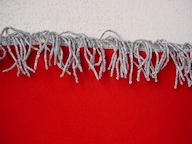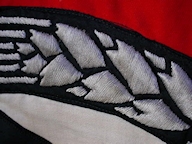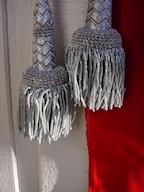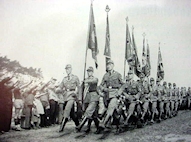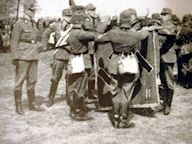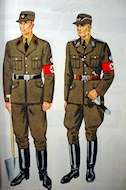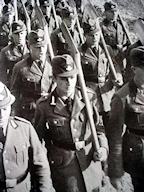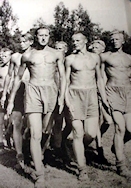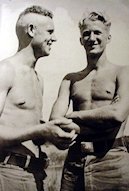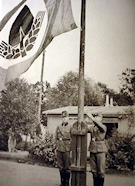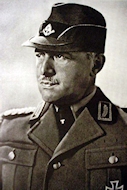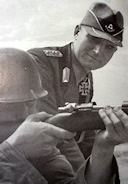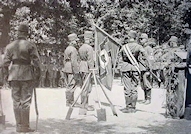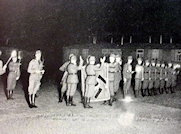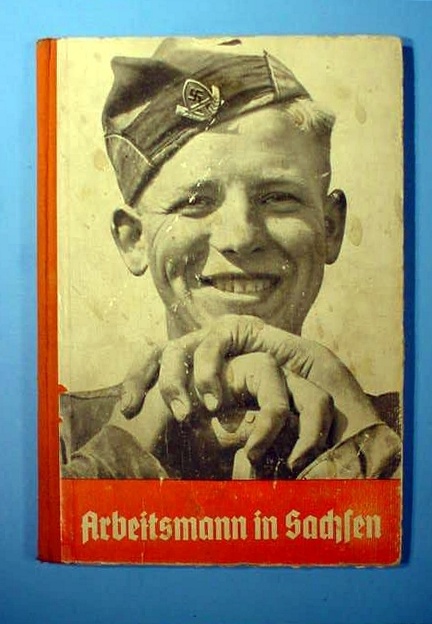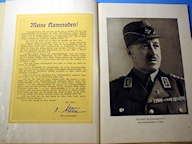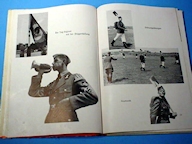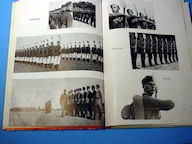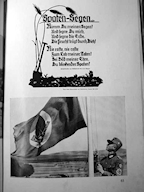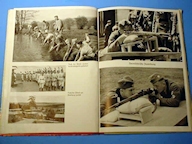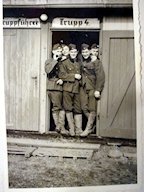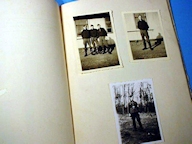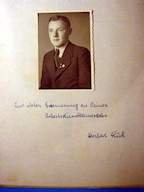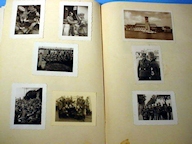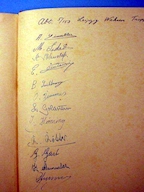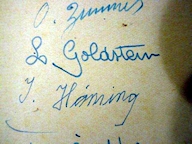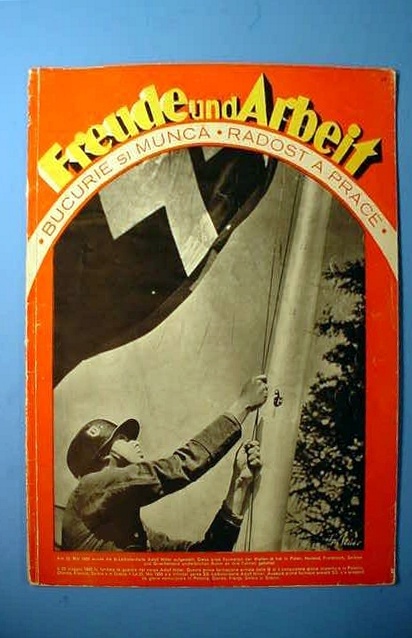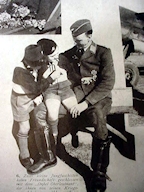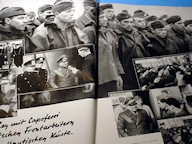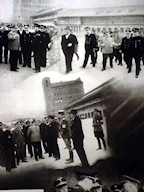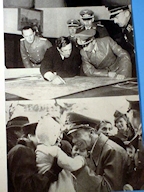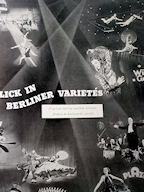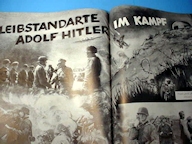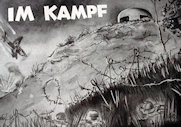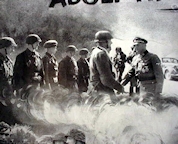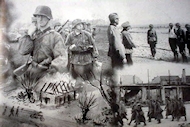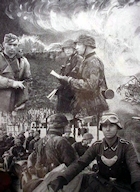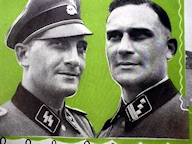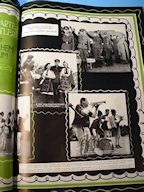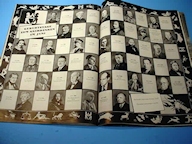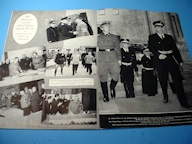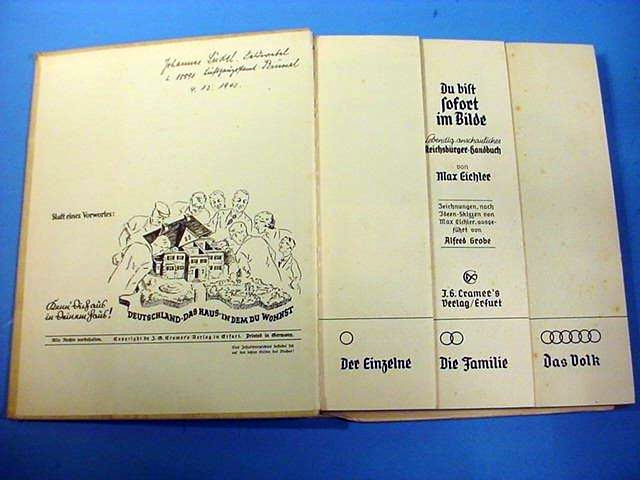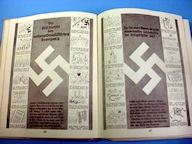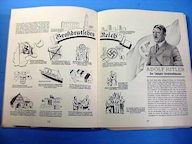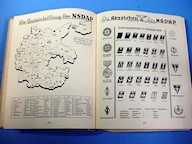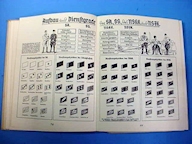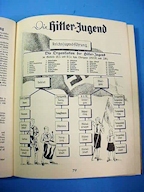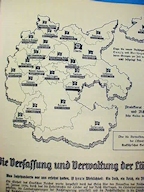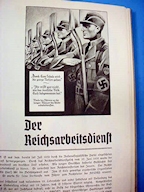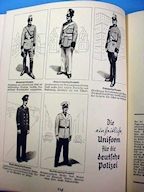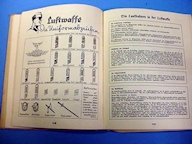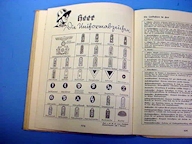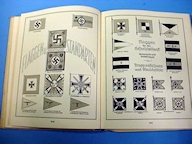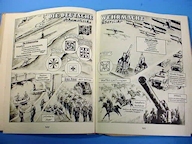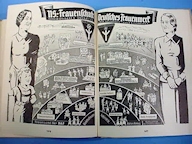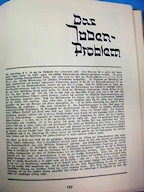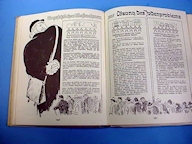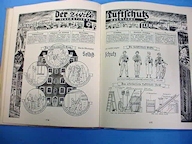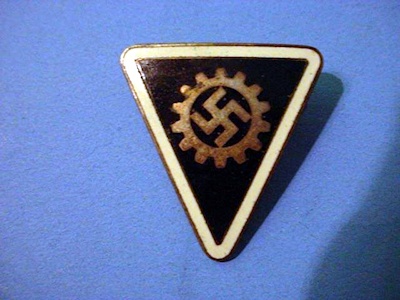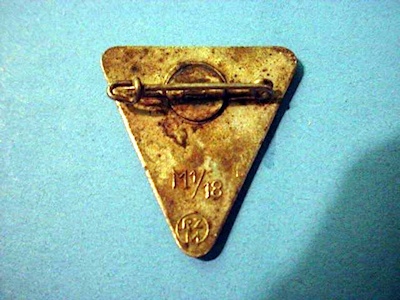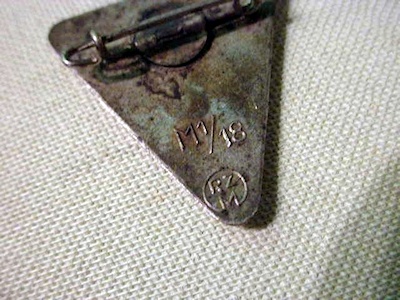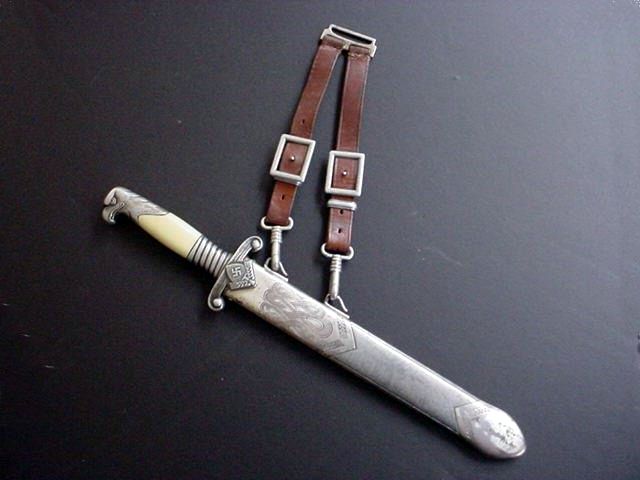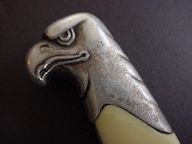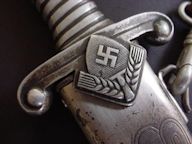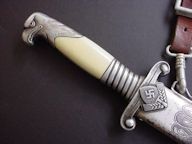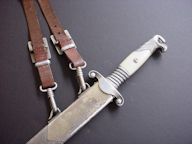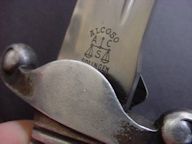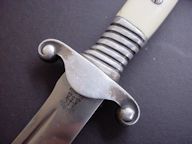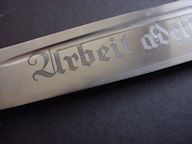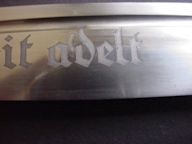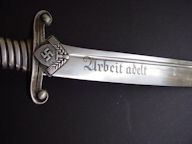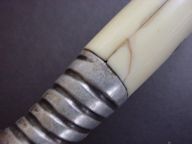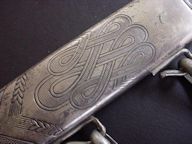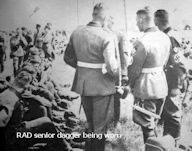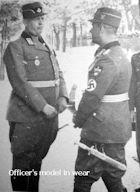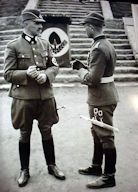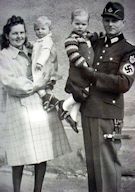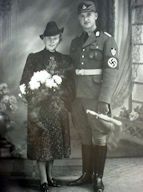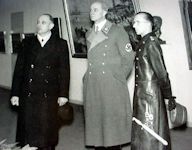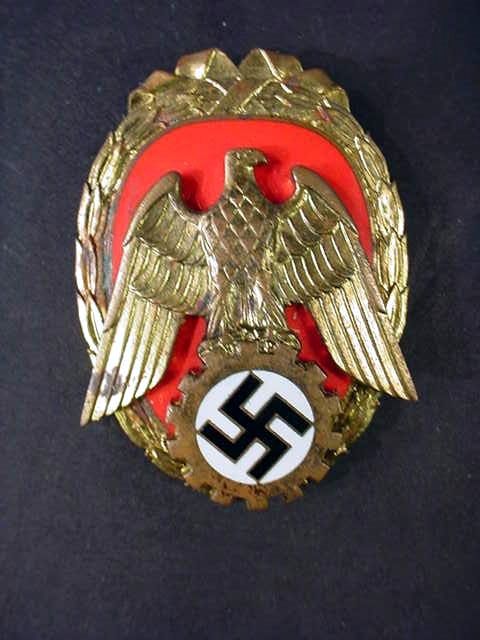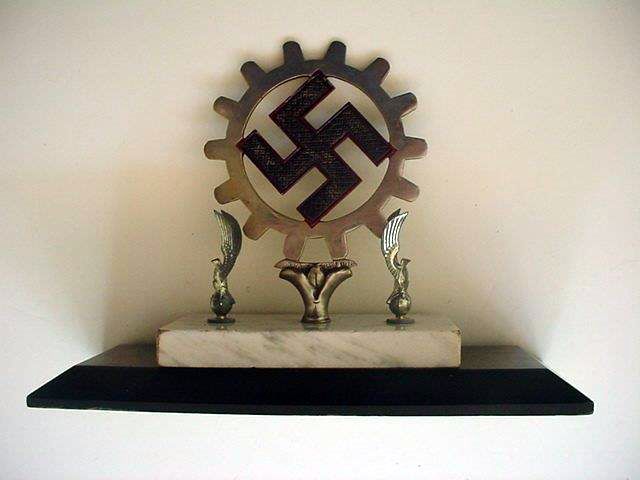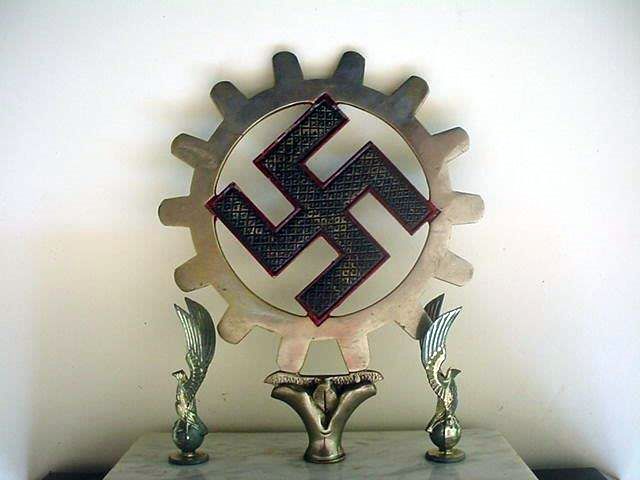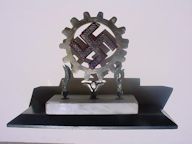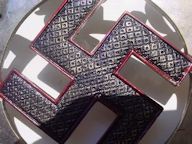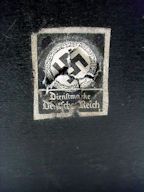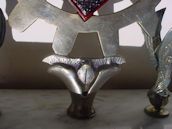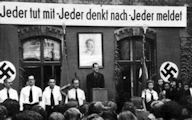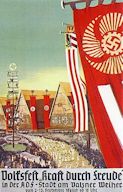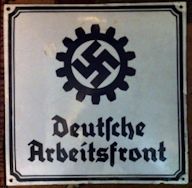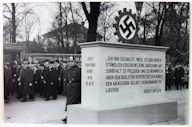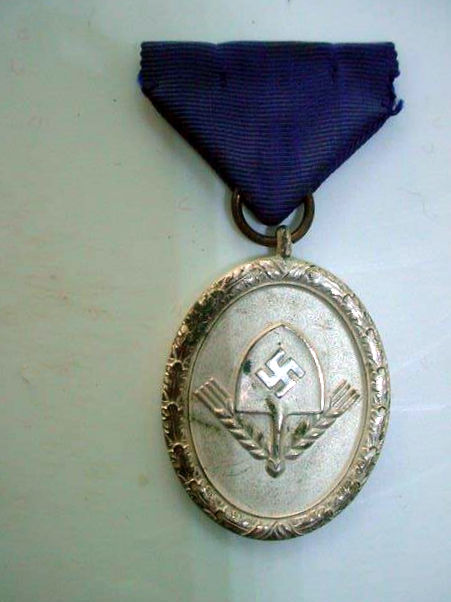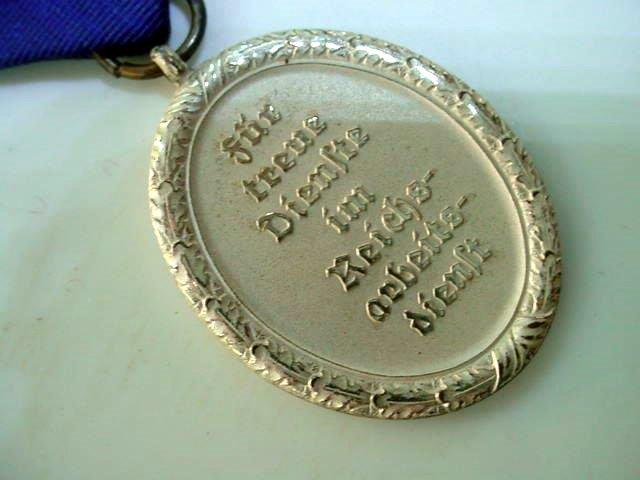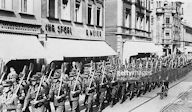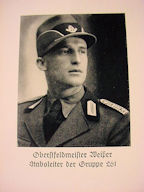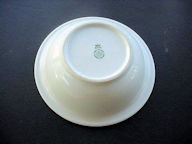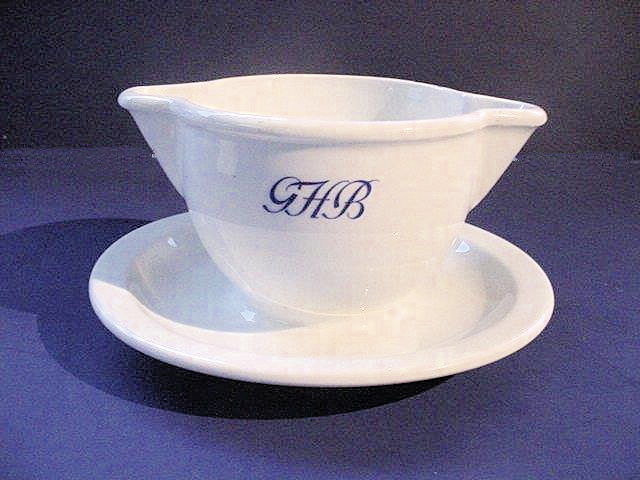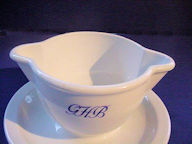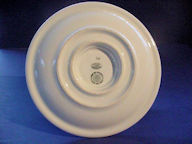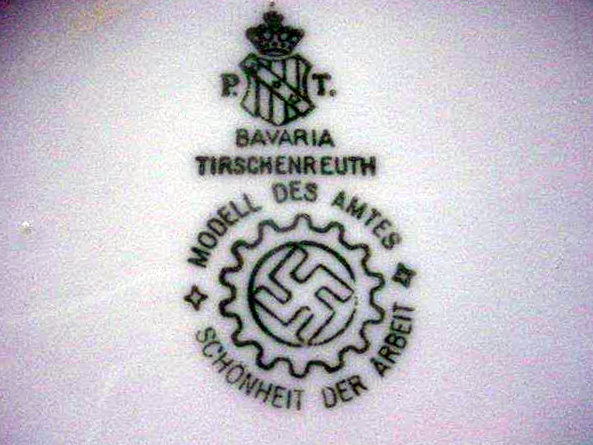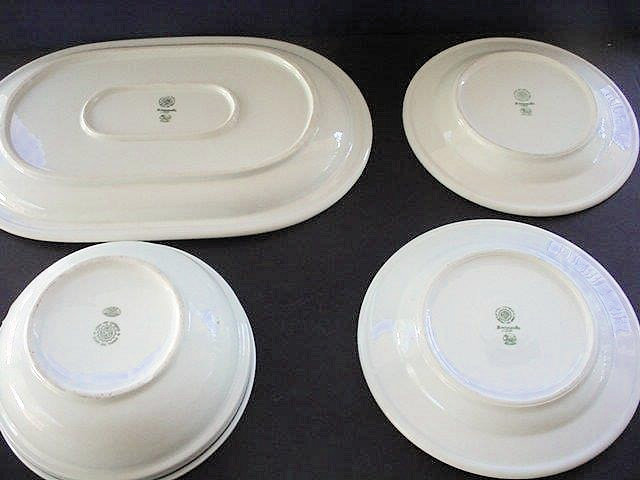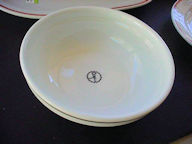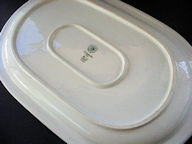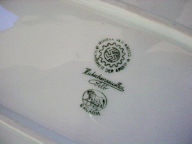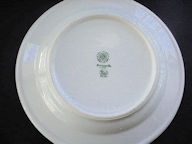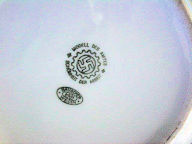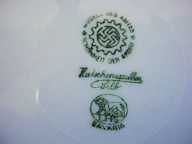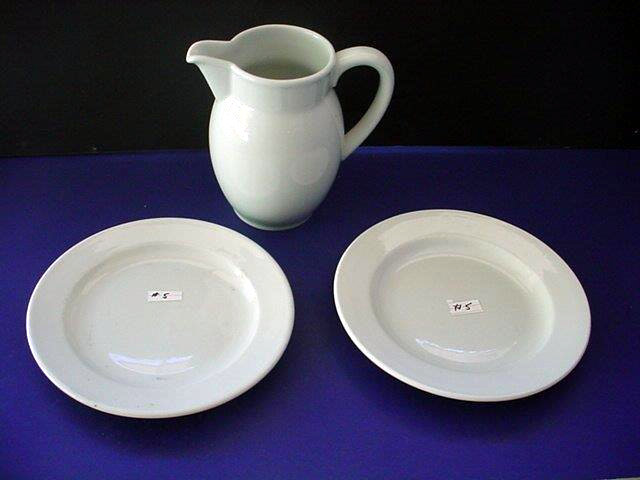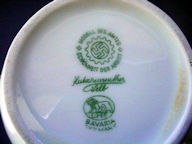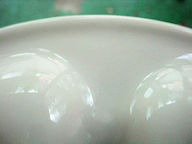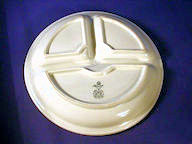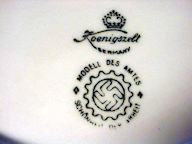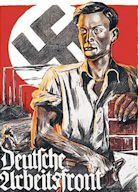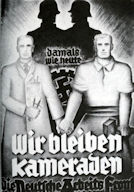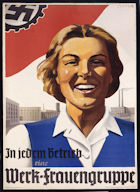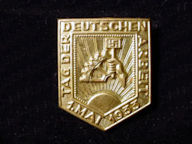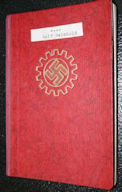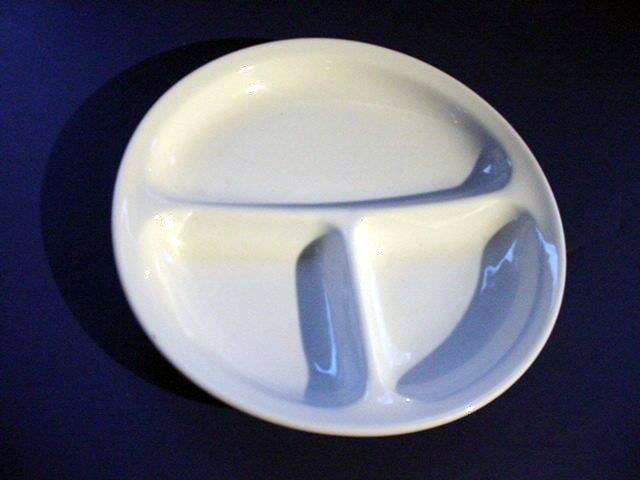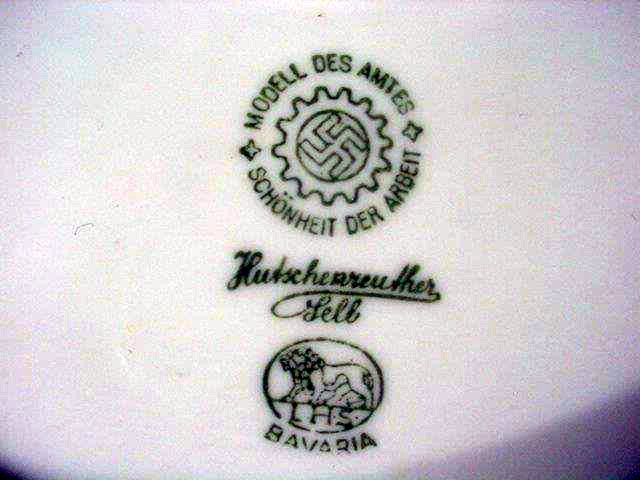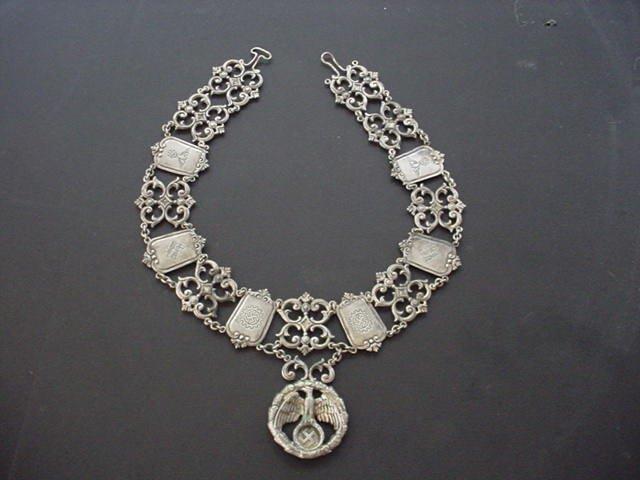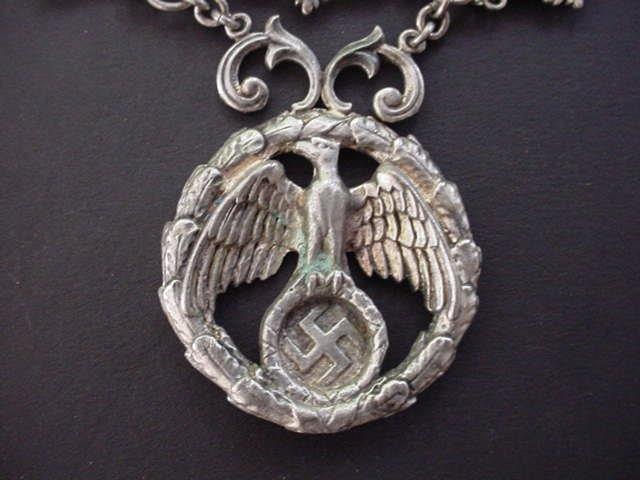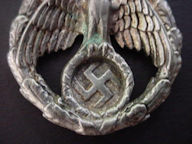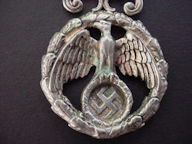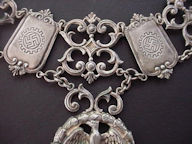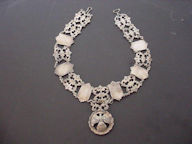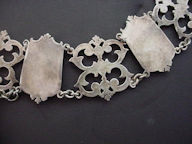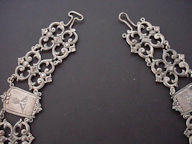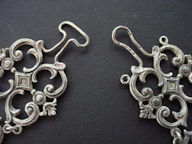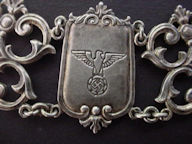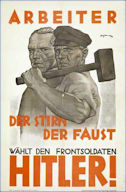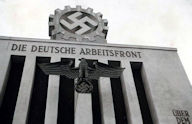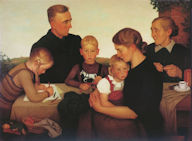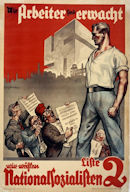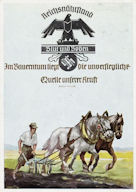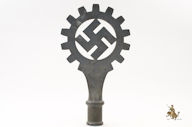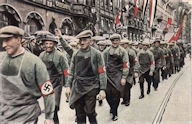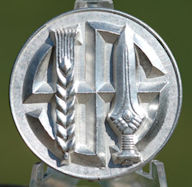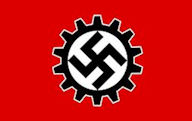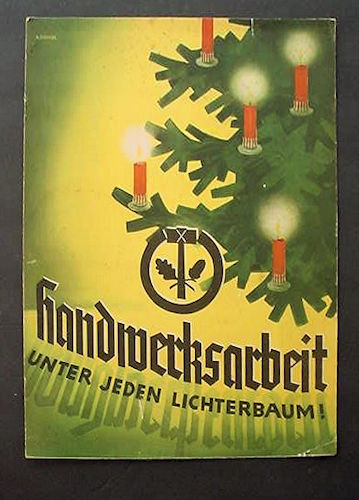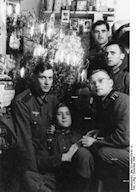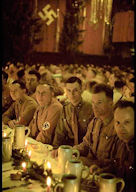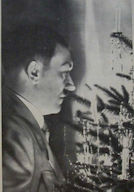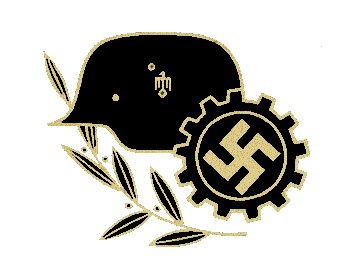|
|
|
|
The Labor Corps and Labor Front
Page 6
|
|
 |
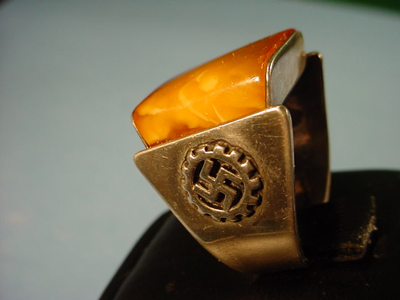 |
A Bernstein Ring from the German
Handworkers Association (RAD 6-1) |
|||||
| DESCRIPTION: This is a very handsome looking ring mounted with Bernstein (amber) that is sacred to the Teutonic peoples of old.
In the Third Reich Bernstein once more became a much venerated stone and was employed in meaningful pieces of jewelry. (Look up amber on Goggle.) This is a ring created by the German handworkers Association which was a section of the D.A.F. (the German Labor Front). It is beautifully constructed in a modernistic setting that is typical of the time “Can you say Art Deco?” The style is imaginative and clever. It has the symbol of the DAF (the cogged wheel swastika) on one side and the symbol of the handworkers on the other side with the hammer with oak leaf and acorn on the other. The Bernstein amber used is Prussian amber, not Balkan. It is much more pure without any imperfections. This is without doubt one of the finer rings of the Third Reich. It is in size 10 ½ and a perfect gem of Third Reich collecting. PRICE: $2,250.00 |
|||||
|
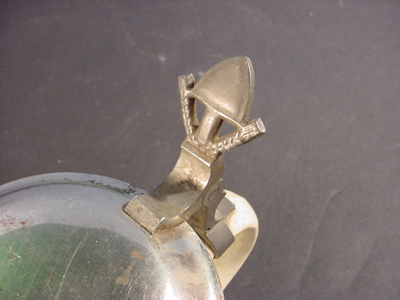 |
Beer Stein of the German Labor Corps (Item RAD 6-2) |
||||
DESCRIPTION: The Reichs Arbeits Dienst was the compulsary labor service unit of the NSDAP. Formed July 1934 as the official state labor service, the RAD was an amalgamation of many labor organizations. It basically was an institution set up in NS Germany as an instrument to combat unemployment, similar to the Civilian Conservation Corps of the U.S., that in fact was a copy of the original RAD. Konstantin Hierl was the leader all through the organization's lifetime. It was a well planned, good organization and it provided jobs, comraderie, snappy uniforms and pride in work for a great segment of Germany's youth. During the ware, the RAD was classified as Wehrmachtgefolge (armed forces auxiliaries). Wouldn't a plan like this be great to put the unemployed to work and as military auxiliaries? They could also be put to work guarding our now penetrated border with Mexico. No illegals need to apply! The stein is in very good condition and measures about 5" high, not counting the thumblift that take the shape of the spade symbolizing the RAD. It entailed hard work but was rewarding in many ways. The saying on the Labor Corps' dagger said it all -- Arbeit Adelt! Work Glorifies! The stein has the spade in the middle of its central design with the time of service of Herr Hans Beck, and in the spade's center is the unit he served in, which was the 10th Brigade and the 238th Regiment. It says (translated)..."In Memory of My Work Service Time in the Region Oberleichtsrsbach." There are some maker marks on the bottom. A very nice momento of the social programs of the Third Reich. PRICE: SOLD | ||||
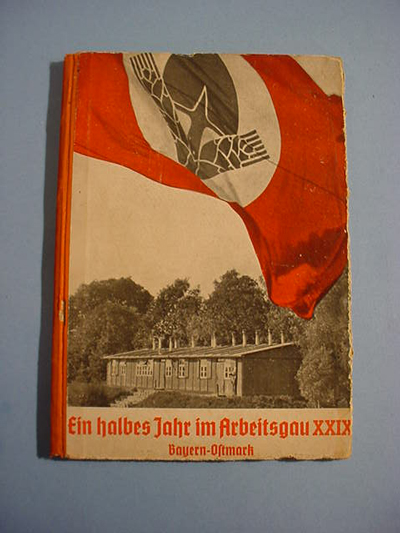 |
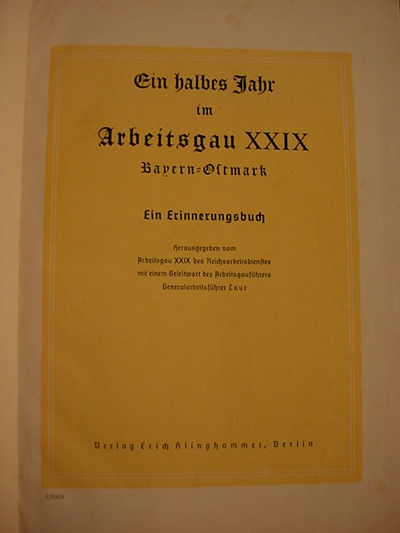 |
Album: Personalized Memory Book for Service in RAD (Item RAD 6-3 & ALBUM 3-2) |
DESCRIPTION: This is a book that was given to Orbeitsmen (Verker Service Men) in some work districts in commemoration of their time spent in this the RAD Reich Arbeits Dienste. This one was the Arbeitgau (Secton) XXIX in the Bavarian (Ost Mark), the East. It is known as a ‘Erinnerungsbuch’ book of memory and it was owned by the worker Josef Biller, born 29 August 1928, and he did his compulsary service from 1 April 1938 to 15 April 1939 in Section 7/297. The document inside is signed by the Oberfeldmeister. The book opens with portraits of Adolf Hitler with the Reichsarbeitsfuhrer heil and another picture of the leader of this section (Arbeitsgaves XXIV Laur). The book has 63 printed pages with many great pictures of men at work and parade, ceremonies, etc. At the back there are some more pages of actual unpublished pictures that were taken by the owner of the book, Arbeitsmann Josef Biller. He shows the camp, the leader, himself, his comrades, their projects and two great pictures of them clowning around. Thirtenn in all in the 3 ½" by 2 ½" size. Then there are 11 of the postage stamp size pictures of further activities. The book is in great shape and seldom does an actual personalized one show up. PRICE: SOLD |
 |
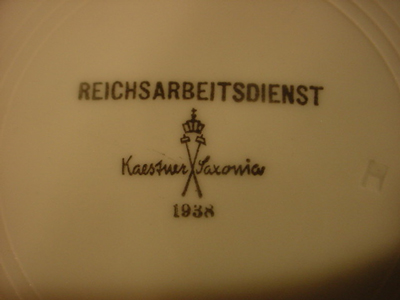 |
China Dinnerware: Bowl (Item WEHR 23-5-Q & NSD 13-5-P & RAD 6-4) |
|
DESCRIPTION: A mess hall bowl 1938 for the Reich Labor Corp (Reichsarbeitsdienst). It was made by the Meissen-based company Kaesfuer, Saxonia and it bears their mark -- crossed swords supporting a crown. The plare measures 9 inches in diameter and in perfect condition. With the usual slight and light food staining in the bowl (natural and expected.) This is much more rare than the army types. PRICE: $135.00 |
|
 |
RAD (Reichsarbeitdienst) Reich Labor Corps Hewer (Item RAD 6-5; Important Third Reich Daggers) |
||
DESCRIPTION: This is the Big Guy of Third Reich daggers -- 15.8" in size. A huge knife used in the field as well as for use with the uniform. The RAD was formed in the late 1920's and used throughout the 30's and 40's. Its leader was Konserntin Hierl. He organized it for the purpose of eliminating the unemployment existing among the youth of Germany. Every young German male was required to serve a period of six months in the RAD prior to joining the army (Wehrmacht). It was a good program and the American CCC (Civilian Conservation Corps) was copied directly from it. With the onset of the war, RAD members were given military training and then were transferred directly into the German armed forces. During the war, RAD members were called upon to level roads and air fields, clear away rubble, collect captured war materials and generally perform manual labor in the liberated territories. This piece is the standard pattern hewer that was worm initially by officers and enlisted personnel. Later, a 1937 model was introduced and this example would only be worn by subordinate ranks. The type shown here is the model 1934. The knife symbolized the objective of this austere labor service -- New land for our people, a new people for our land. The motto on the blade "Arbeit Adelt" means Labor Enobles. The dagger offered here is by Carl Jul. Krebs of Solingen and bears the #538 on the blade. Krebs had the original contract with the RAD and his examples were the best always. Our pictured hewer is in near mint condition and remarkably without the usual dents, abrasions, etc. caused by vigorous usage. Generally the top of the backstrap is banged up from the owners tacking up notices, etc. Ninety percent of the time this is noted on these particular weapons. The blade is thankfully not sharpened and the words stand out clearly. The throat end cap (or boot) are pristine. The scabbard may be repainted, but if so, done right. And, there is the possibility it was re-painted back then in the time of the Third Reich. This was often done. This piece is complete with its large accompanying black leather hanger. This is the full hanger (very rare); hanger in three parts. Tom Johnson, in his magnificent volume, "German Daggers of WWI: A Photographic Reference" shows a E. Pack and Sohne model with the full three part hanger on page 498. The hanger is a bit used; shows some light deterioration, but is holding. The hanger clip that actually holds the dagger is marked with the Assmann symbol. This is an all around complete and excellent plus RAD hewer. One would be hard pressed to find a better one than this. PRICE: $2,250.00 |
 |
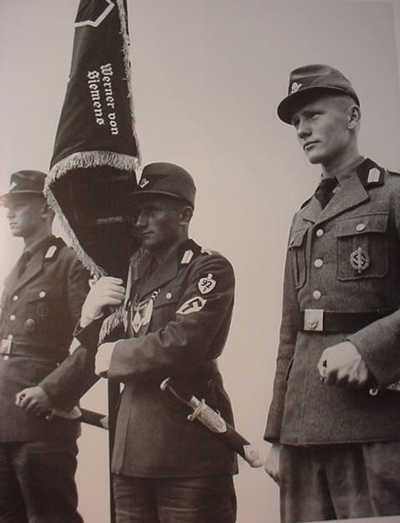 |
Ein Deutsches Reichsarbeitsdienst Hewer (German Labor Corp Dagger) (Item RAD 6-5a; Important Third Reich Daggers) |
| DESCRIPTION: Here is a very fine example of the RAD Hewer (dagger) (Reichsarbeitsdienst) or Reich Labor Service. This was the organization that actually saved the German workers from the horrors of the Depression in the years starting with 1934. Youngsters served a six month program of camp life while being taught the merits of public labor. It was one of the greatest social programs of the 20th century. In many ways lads from rich families served beside the farm boys and the sons of factory workers in a group effort to benefit not only themselves but their German Fatherland. The program was actually copied by the war criminal Franklin D. Roosevelt when he initiated the WPA (there is more on the internet). The men were issued sharp looking militaristic uniforms and they were trained not only in civil engineering and strategy but they took on a work ethic and national responsibility that prepared them for their future. A program that is so surely needed in our western culture today. (‘Arbeit Adelt) ‘Work Glorifies’! This was the motto that resounded in their hearts and appeared on the blades of the Hewers. This was indeed an important role in the life of a patriotic youth in the Third Reich of Adolf Hitler and the NSDAP.
The most welcome issued item to these officers and men of the RAD was this large Hewer (dagger). In earlier years of the program the officers and enlisted personal wore the same edged weapon, with stag grip. It was not until 1938 that the officers were issued a scaled down version with white celluloid grips actually quite different. The piece we offer here is one manufactured by Ed Wusthof of Solingen and is in very fine condition but the scabbard is repainted (but a fine job). This repainting was and is common in regards to these RAD pieces. Yes, they were dress daggers that were supposed to be worn only while not engaged in work of course. But in practically every hour otherwise these daggers were extensively worn then why were the scabbards In need of constant repainting? Precisely because of this constant usage. Also seldom does one ever see one of these that does not have a back strap between the stag horn grips that is not somewhat scarred. Especially ones that were issued to officers and group leaders, reason: Almost every day various duty notices were nailed up on posts, walls, etc. This usually means that one would have to go get a hammer! Well why do that when a very heavy implement was hanging right there suspended from your belt ready to use! Now you understand why the daggers invariably have nicks, scratches and dents in this area. How nice to have a dress dagger and a handy tool at the same time! We have said that this one is a very fine example in a good state of preservation. All the screws are in place and original. The scabbard is straight throughout. The scabbard mounts are nickel plated as are the cross guard and all metal parts of the grip. The blade is fine but like 99% of these daggers of the RAD there are signs of minor sharpening. The firm’s name is underneath the logo and the patent pending words “Ges, Gesch" are seen as well. Now! This dagger has the hanger device that is known as the long bullet hanger. The piece is in brown color leather. The reverse of the clip on the hanger has the mark (logo) of Assmann one of the chief makers of N.S. insignia and accoutrements such as this you can see in our pictures the DRGM markings also besides this, it has the inverted triangle with RAD logo and the date the hanger and probably the dagger were produced (’35’). This snap clip buckle has a fine looking patina across its surfaces. To find a hewer with the hanger is almost impossible today. Better grab this one. They are disappearing from the scene rapidly and this is an excellent plus example. PRICE: $1,950.00 truly a bargain. |
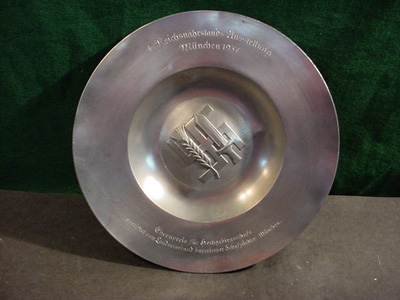 |
| Honor Prize from the Reichsnahrstands Exhibition 1937 (Item RAD 6-6 & GEN 14-9) |
DESCRIPTION: This is a beautiful pewter dish that is quite large, about 14 inches in diameter with the symbol of the Reichsnahrstand. This was a social organization that was formed by the Reichsminister for agriculture and the distribution of food-stuff, Reichsleiter Walter Darre. This was a powerful office empowered to intervene and regulate all agriculture. The title means “Reich Food Estate.” The RNS was responsible for price controls and the quality of farm produce. Exhibitions were sponsored all over the Reich of farming techniques employed in all functions of farming; even with the antagonism against the Third Reich which is still prevalent today, serious conservation minded persons respect and admire Walter Darre and this organization for its outstanding work in the fields of animal husbandry, sowing the soil and generally making the lot of the farmer as important as it surely should be (favored!). Farming was lifted to the level of importance with all the other critical functions of governmental administration within the Third Reich. The Zinn pewter plate we offer is a prize given at the Fourth Grand Exhibition of the Reichsnahrstand held in Munich in 1937 (71 years ago). This was the honor prize given by the organization with the Bavarian county-authority. The prize was presented for excellence and supreme efficacy in sheep herding (shepherding). The dish is in solid first grade pewter and of course pure pewter is a soft metallic material so over the years a few dents and bulges have been acquired but they just do not detract from the apparent beauty of the piece. The wheat sheath that lies across the swastika symbolizes the importance of agriculture to the well-being of the German nation while the sword is symbolic of the strength of the people as a result of effective use of the gifts of the earth. A very meaningful relic of the great social experiment brought low by the terrible fratricidal war, this is a wonderful example of an important ‘Blood and Soil’ item. The Germans were quite aware that the health of the people came directly from the strength of the soil and its abundance. PRICE: $1,300.00 |
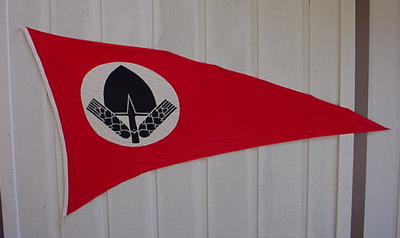 |
A Large Labor Corps Pennant (RAD 6-7 & FLAG 2-11) |
DESCRIPTION: Here in mint condition is a ‘Wimpel’ or Banner of the Reichsarbeitsdienst or Labor Service (RAD). This was an institution established by National Socialist Germany as an agency to reduce unemployment similar to but much superior to the relief programs in other countries during WWII. It was an auxiliary formation which provided support for the Wehrmacht. In July 1934 The RAD was formed and designated as the official state labor service. The RAD was an amalgamation of the many labor organizations formed in Germany during the time of the Weimar Republic. RAD members were to provide services for various civil, military and agricultural construction projects. Party leader Konstantin Hirel was its director during the organizations entire lifetime. The RAD was divided into two major sections The RAD manner for men and the RAD-Wj for women. The House Flag or banner that we offer has the official symbol of the corps in its center. This symbol was popularly known as “Die kaffeebohne” (The coffee bean’). This one is for the men’s camp and sections. The women’s was similar, but had the wheat sheaths but no spade. Instead, it bore the swastika. This wimple measures 79 x 46 inches long and as we stated it is in mint condition with bunting edge for pole mounting. A very beautiful example of a rare ensign PRICE: SOLD |
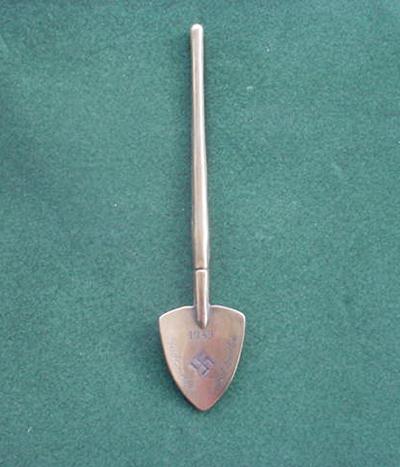 |
 |
Unique Miniature Labor Corp Spade (Letter Opener) (Item RAD 6-8) |
DESCRIPTION: This is a great little art piece from a family whose deceased father was in the thick of fighting for his Fatherland in WWII. This miniature spade in brass, however, was from his time in the German Labor Service (RAD) that he served in within the Berlin area prior to WWII. We are told that all the men of his particular unit received these beautiful letter openers in the form of a spade at the completion of an important building project near Berlin in 1939. The blade of the spade is engraved with the swastika and the year 1939 pus the words Reichs Arbeits Dienst Berlin; it is about 7 ¼ inches long in solid brass and is just a wonderful RAD memento and a very historically important piece. PRICE: SOLD |
|
|
|
Brooch of the NS Women’s Labor Corps (RADwJ) (Item RAD 6-10; NSDAP 18-36) |
|
DESCRIPTION: For the express purpose of helping to alleviate some of the mass unemployment that continued in Europe during the great depression, Germany formed the first voluntary labor service for females in 1932. This organization was originally part of the NS—Frauenschaft (National Socialist Women’s League), but by 1936 became part of the Reichsarbeitsdienst (RAD) (National Labor Service), first known as the Deutscher-Frauenarbeitsdienst (German Women’s Labor Service). It later became the Reichsarbeitsdienst der weiblichen Jugend (RADwJ). During this time the organization changed from a purely voluntary to a compulsory basis for its membership. Seventeen- to twenty-one-year-old girls were drafted for six months’ duty with an average of 30,000 annual draftees. The RADwJ organization became an important part of the war efforts when the western Allies declared war on Germany. Though it never became very large in numbers compared to other German labor organizations in the beginning, labor camps were set up across Germany where the new female recruits participated in athletic workouts, gymnastics, and field games along with training in childcare, medical assistance, and agricultural work. Their structured camp life was centered on teaching German women to be good mothers and good citizens of the Fatherland. As the ensuing war waged against Germany by the Allies became extremely brutal many young women in German and supporting lands participated along with the brave soldiers and died defending hearth and home through the vengeful bombing and outright brutality of these who claimed the victory. The badge is the earliest of several models (labor designated) that were used from 1936 to 1937 and it consisted of plated steel. It measures 44mm round and has a convex pin on back of badge. The front surface was embossed with “Arbeit für Dein Volk, Adelt Dich selbst—Deutscher Frauenarbeitsdienst” (Work for your people, ennoble yourself, German Women’s Labor Service) around the edge. In the center is an arrangement of six barley stalks surrounding a swastika poised on point to symbolize motion. Each badge had a hand-stamped serial number on its reverse that identified the member recipient. These badges were worn as a brooch at the nape of the neck or blouse closure. The lady who proudly wore this badge was a woman who heard the appeal of the folk community, her nation, and Führer and could say: “Ich leben für Deutschland.”
(I have known several of them) God Bless them all!
PRICE: $450.00 |
|
|



